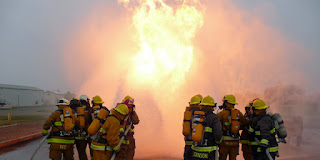Fire Safety Training: A Critical Component of Workplace Safety
Fires can happen anytime and anywhere,
including in the workplace. The impact of a fire can be devastating, causing
property damage, injuries, or fatalities. The best way to prevent fires from
occurring and to minimize the damage when they do is to ensure that all
employees are trained in fire safety. In this article, we will discuss the
importance of fire safety training and what it should include.
Why
Fire Safety Training is Important
The primary reason for fire safety training is to ensure the safety of employees. In the
event of a fire, every second counts. By educating employees on how to prevent
fires and how to respond in case of an emergency, organizations can help ensure
that employees can react quickly and appropriately to minimize the risk of
injury or death. This training can also help minimize property damage and
operational disruption by addressing a fire in its early stages.
Fire safety training is also required by law.
The Occupational Safety and Health Administration (OSHA) mandates that all
employees receive fire safety training. This training must cover a variety of
topics, including evacuation procedures, fire prevention, and the proper use of
fire extinguishers. Failure to comply with these regulations can result in
significant fines, as well as legal and reputational damage.
Finally, fire safety training can help prevent
fires from occurring in the workplace. By educating employees on the potential
causes of fires and how to handle flammable materials safely, organizations can
take proactive steps to reduce the risk of a fire breaking out.
What
Should Fire Safety Training Include?
There are several key components that should
be included in any fire safety training program. These include:
1.
Fire prevention
The first step in fire safety training is to
teach employees how to prevent fires from occurring. This can include proper
storage and handling of flammable materials, regular equipment maintenance, and
other proactive measures to minimize the risk of a fire breaking out.
2.
Emergency response
In the event of a fire, every second counts.
Employees must be trained on how to respond quickly and appropriately to
minimize the risk of injury or death. This can include evacuation procedures,
the use of fire extinguishers, and other emergency response protocols.
3.
Evacuation procedures
In the event of a fire, employees must know
how to evacuate the building safely and efficiently. This includes identifying
the nearest exit, knowing alternative escape routes, and understanding how to
assist those with mobility issues.
4.
The proper use of fire extinguishers
Fire extinguishers can be a critical tool in
managing a fire in its early stages. Employees must be trained on the different
types of fire extinguishers, how to use them properly, and when it is
appropriate to use them.
5.
Communication protocols
In an emergency situation, communication is
essential. Employees must be trained on how to communicate effectively with
their coworkers, emergency responders, and others involved in the emergency
response.
6.
Ongoing training
Fire safety training should not be a one-time
event. Instead, organizations must provide ongoing training to ensure that
employees remain proficient in fire safety. This includes regular refresher
courses, updates on changes to emergency response protocols, and additional
training for new employees.
Conclusion
In conclusion, fire safety training is a critical component of workplace safety.
Every employee must know how to prevent fires, how to respond in case of an
emergency, and how to use fire extinguishers properly. By providing
comprehensive fire safety training, organizations can help minimize the risk of
a fire breaking out and ensure the safety of their employees. It is essential
to provide ongoing training to ensure that employees remain prepared and
proficient in fire safety, which can save lives and prevent damage in the event
of an emergency.



Comments
Post a Comment